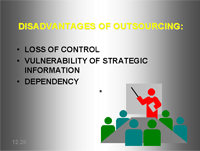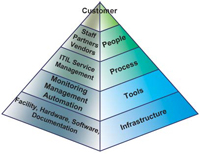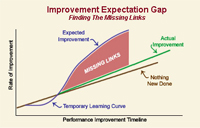Outsourcing IT Functions



Introduction
Outsourcing is the contracting of various business activities to a business entity that specializes in managing and operating these activities. In the outsourcing of IT functions, the outsourced activities may include applications development, applications maintenance and enhancement, computer operations, data communications network operations, and voice communications network management.
Computer operations that are closely integrated with business processes – such as the use of PCs, workstations and client-server systems are rarely outsourced. However, the selection, procurement, training support and maintenance may be outsourced.
Definitions 
Outsourcing is a contractual relationship in which the responsibility for a function or task is handed to an external supplier for a fixed period of time. Therefore IT outsourcing is where a specialist area – such as the maintenance of network operations is undertaken by an external business entity.
Insourcing is where the outsourcing option is evaluated and matched with the capacity of the internal IT department to retain the IT functions within the business, rather than moving the operation to an external business.
Multisourcing is where the IT functions are outsourced to a group of external businesses.
Offsourcing – or offshore outsourcing - is the practice of using offshore companies to design, develop and implement computer systems. An Australian organisation may outsource part of its operations to an offshore business where there are clearly defined benefits (in terms of quality, cost and time) in this move.
Evolution of Outsourcing
In the first generation of outsourcing, the emphasis was on gaining efficiency and reducing cost by targeting processes and functions that were not the primary business of the organization. Therefore, in many businesses administration, human resources, accounting, and IT functions were targeted for outsourcing. As computer systems became more complex, the trend to outsource IT strengthened, much to the benefit of IBM, Andersen Consulting and EDS.
However, a business’s core competence – the work that delivered business value – was never outsourced, as it was too risky to have “outsiders” involved with the customers and their needs.
In the second generation the outsourcing boom extends well beyond computer operations and similar functions. A major initiative is outsourcing in the form of contract management as a way to cut costs.
As a result outsourcing is changing the nature of the relationship between contract manufacturers and the original equipment manufacturers (OEMs).
Commitment and above all trust are vital to the success of these relationships.
In the third generation, companies outsource in the form of investment partnerships. These outsourcing alliances have a variety of names, including e-business webs, venture kieratsu (a Japanese concept of a mutually beneficial collaboration), clusters, and coalitions.
Although successful outsourcing strategies differ widely from industry to industry, all share a common purpose. Each strategy seeks to nullify the advantages of the industry leader by using outsourcing to quickly create a reputation, powerful economies of scale, cumulative learning, and preferred access to suppliers or channels.
What to Outsource?
Consider the following questions:
- What activities are strategic business? These must not be outsourced.
- Will it save at least 15%?
- Does your organisation have access to the latest technology and expertise?
- Does outsourcing increase the organization’s flexibility?

What not to Outsource - There are four core IT functional activities that should not be outsourced:
- Strategic planning and strategy decision making.
- The architecture of the IT system.
- The management of the vendor.
- Decisions on implementing IT.
 The Advantages of Outsourcing
The Advantages of Outsourcing
- It is cost efficient, it can save capital investment and release funds and resources for new business ventures.
- Provides an improved quality of service where the vendor is a specialist, and therefore is more up-to-date than an internal department.
- It can help avoid executive disenchantment with IT.
- It can help bring about cultural change in an organization.
- Change the focus of the organization by concentrating on strategic objectives and core business.
- Reduce the tension between senior management and IT management (where IT feels it has been sidelined).
- Reduce recruitment problems and the cost of training staff to use new technologies.
- Dumps the IT tasks that are purely operational and concentrates on meeting critical and strategic needs.
 Disadvantages of Outsourcing
Disadvantages of Outsourcing
- Vendors are likely to exaggerate their successes and capabilities, so the outsourcing company must be cautious.
- Loss of control, especially where a business is dependent on information stored on their computers.
- Outsourcing is complex to manage, especially where complex software is used.
- The company may need to be on the cutting edge of IT advances, but is “locked” into a contract.
- There can be disagreement about the importance of a problem.
- Decisions by vendors can be hard to reverse.
- The vendor may not be concerned about environmental issues.
- The vendor may take a haphazard approach to business performance.
- Small companies have difficulty negotiating cost structures with vendors.
- Long-term contracts are contrary to a lot of IT planning, so a review process needs to be in place.
- Loss of expert staff can lock a business into outsourcing as it becomes difficult to regain IT skills.
- May have to use multiple vendors so that management and control is retained by the company.
- The outsourcing contract must allow a changeover to the vendor without causing downtime in IT services.
- Loss of copyright etc when software is transferred to the vendor, or problems with software licencing requirements.
- Loss of core competencies due to poor planning.
- Creation of bad staff relations due to outsourcing.
- Exit barriers for businesses, making it hard to easily move to another vendor.
 Effects of Outsourcing
Effects of Outsourcing
- IT (outsourced) will “fit” into the business model like all other departments.
- IT managers become contract managers.
- A dedicated vendor will deliver higher levels of expertise.
- Some IT staff may be transferred to the vendor. This will mean a new culture, location and benefits (or otherwise) for these staff.
- Outsourcing will require the IT manager to be up-to-date without being hands-on.
- A specialist vendor will offer faster response times in decision-making.
- The inhouse IT group is now responsible for strategy, policy and contract management.
 Impact on Staff
Impact on Staff
Problems arise where senior management consider outsourcing as purely a strategic decision of resource allocation. This can be very painful for IT professions - who feel that they are treated like commodity – and moved from one position to another with the hardware.
For some people outsourcing is an opportunity to move their career forwards, but for others they will be concerned about the changes, and any move will be traumatic.
The severity of this impact on the staff will depend on their skills, the attitude of the vendor, and their position in the business.
Staff who make the move to a vendor can face major problems, that include:
- Change in culture.
- Lack of understanding of the communication systems.
- Their role is diminished and authority level changed.
- Redundant staff are employed by vendors as contractors, on very limited term contracts.
- Permanent staff members find themselves in a mobile workforce that moves from one contract to the next.
- Transferred staff find the environment hostile, and hard to perform well in.
 Vendor Issues
Vendor Issues
A business must be certain that the vendor is committed to the long-term. Therefore:
- Always tender for outsourcing vendors so set objectives may be achieved.
- Be specific about required service levels, and include penalties for non-delivery.
- Have a precise exit strategy clause in case the vendor fails to meet the service level required.
- Check that the vendor has ethical standards to prevent your business data from being compromised.
When negotiating a contract try to retain the “balance of power” by:
- Meet with the main competitors of the best vendor.
- In the final stages of negotiation push hard for the best possible contract. Never rush a contract – allow at least three months.
- Obtain a full cost breakdown and check for inconsistencies. Where these occur, use them to suggest you will “cherry-pick” the best deals from a selection of vendors.
- If necessary, use a consultant – or the most senior and experienced manager available – for the final negotiations.
 Impact on IT Department
Impact on IT Department
- Escalating costs – experienced outsourcing contractor will be certain that their contracts include provisions for additional charges incurred as a result of the buyer’s failures or actions that result in additional work.
- Inadequate emergency response – where control over the contractor is difficult, and the contractor is seeking to achieve “economies of scale” by combining the work of several customers into one facility, and “balancing” their needs. The same applies to disaster recovery.
- Information security – although there will be contractual obligations on the vendor, the burden of ensuring the confidentiality and integrity of your data will remain with your company.
- Financial reliability – if the contractor ends up in court with financial problems, the customer may find their data and processing capabilities unavailable through a court-ordered lock-up of the contractors’ facilities. The contracts therefore need to clearly state the ownership of any data procedures and programs, and also specify the information that is proprietary to your company.
- Technological change – must consider what drive the adoption of new technology, and who will pay for it?
- Systems architecture change – beware the contractor that wants to change the systems architecture to achieve “economies of scale”. Rather the systems architecture must meet the service demands and strategic needs of the customer.
- also – need to consider software licence fees, termination penalties, and performance measurement.
Selecting Vendors
Must consider:
- IT expertise of the contractor.
- Hardware and software capacity of the contractor.
- Financial security of the contractor.
- Cultural perspective of the contractor – is it aligned with your business.
- The size of the competition.
- The complexity of the IT situation, and the likely impact of change.
- The period of the outsourcing contract, and the risk associated with uncertainty about the future, especially with regard to IT.
 Performance Measuring
Performance Measuring
- Set the level of task accuracy.
- Critical tasks may have defined time limits for completion.
- Defined response times for generic tasks.
- Rate of on-time completion
- System availability.
- Productivity improvements – in systems development contracts can use function point analysis.
- Defined priorities for task allocation.
- Impact of hardware failure and achievement of reactivation times.
Best Practice - Check the contractor’s performance in terms of:
- Ability to set strategic goals and achieve set objectives.
- The rules in place to deal with contingency events.
- Ability to plan and estimate the adequate time and resources to complete a task.
- Monitoring processes to ensure high level of quality.
- Employment of highly professional IT staff and consultants.
- Open communication between contractor and customers.
- Is the contractor a learning organisation?
 Conclusion
Conclusion
Complex outsourcing arrangements are not optional anymore – they are the only way that businesses are able to fill the need for specialist skills. However, few guidelines exist for managers to use when they wish to create new business designs that leverage outsourcing.
The key thing to remember when outsourcing IT functions is that the contractor is not your business partner!
They are separate firms that must maximize profits to satisfy their shareholders – and as a result – their business interests cannot be the same as those of your organisation.
What do you know? What do you need to know?
For reading and review quesions - this is your chance to discuss answers with your lecturer.


